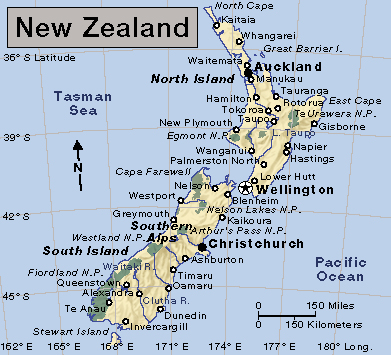The Maori are the indigenous (native) people of New Zealand. New Zealand is also known by the traditional Maori name Aotearoa. Te Reo, the Maori language, is a Polynesian language that evolved in isolation in New Zealand over hundreds of years. The language is most closely related to the languages of the Society and Cook Islands more than 2,000 miles (3,200 kilometers) to the northeast in the Pacific Ocean. Most scholars believe Maori first settled New Zealand around A.D. 1200. According to Maori tradition, however, they began arriving more than 1,800 years ago. They arrived in huge, double-hulled seafaring canoes.
The Maori language of Te Reo was traditionally only oral. There was no writing system. Stories were passed down through generations via songs, called waiata, which commemorated important events. Other tales and traditions were communicated through carvings, weaving, and tattooing.
By the 1700's, all New Zealand was populated by different Maori groups. Most lived in small isolated villages, where people fished and hunted and also grew crops. Each group had a traditional territory, and conflict between groups was common. Relationships between groups were established and maintained through large gatherings and elaborate rituals to celebrate various rites of passage.

Maori gatherings often begin with a ritual greeting called powhiri. This ceremonial greeting usually starts outside the marae, the open meeting ground at the center of a Maori village. As visitors arrive, a warrior from the host village will challenge guests, to see whether they are friend or foe. He may be armed with a spear, but he will also lay down a small leafy branch before the visitors. The visitors pick up the token to show that they come in peace. This initial ritual is followed by various calls by the hosts and responses by the visitors as they enter the marae. After everyone is seated, a series of speeches and songs follows, usually from elders of each group. Once the speeches are completed, the visitors present their hosts a gift. The ceremony ends with a hongi—the traditional Maori touching of noses—and food is shared.
In the early 1800’s, Te Reo was the predominant language spoken in New Zealand. As more English speakers arrived in New Zealand, the Maori language was increasingly confined to Maori communities. Over time, the Maori language was suppressed in schools, either formally or informally, in an attempt to ensure Maori children would assimilate with the wider European community in New Zealand. By the mid-1900’s, linguists were concerned that the Maori language was at risk of disappearing.
Beginning in the early 1970’s, a number of Maori student organizations initiated a revival of their traditional language. On Sept. 14, 1972, the organizations petitioned Parliament to request that Maori language classes be offered in schools. Beginning in 1975, this event has been recognized and celebrated during Te Wiki o Te Reo Maori (Maori language week). In 1978, New Zealand’s first bilingual school opened at Ruatoki. The first Maori-owned Maori-language radio station hit the airwaves in 1983. Today, about 125,000 people of Maori ethnicity speak and understand Te Reo. It is also recognized as one of the three official languages of New Zealand, along with English and New Zealand Sign Language.
Image 1: Maori flag. © Julinzy/Shutterstock
Image 2: New Zealand. Credit: WORLD BOOK map